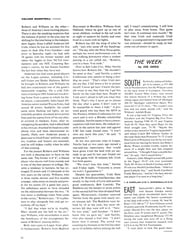
When a race breathes no more
Part of the price we've paid for our nation's rapid growth has been the permanent loss of some of our wild creatures. The passenger pigeon, the plains wolf and heath hen are names that echo accusingly through our short history. Man's ravages have already driven 47 species of U.S. wildlife over the brink of extinction. More than 120 species have disappeared throughout the world since 1600. Today hundreds of the earth's living animals, assaulted by pollution poisons, loss of habitat and overexploitation, face a similar fate.
Naturalist William Beebe said, "When the last individual of a race of living things breathes no more, another Heaven and another Earth must pass before such a one can be again."
Since we do not have the capacity or technology to create another Heaven or Earth, we had best be wary of what we destroy. We have begun to understand the fragile web of life of which we are but a precious part. We are also becoming painfully aware that man is the only species that willfully damages that web for reasons of greed, hatred or ignorance. Too many of our scientists have warned us that, unless we stop now, one too many species of wildlife soon may be wiped out, one too many lakes or rivers fouled beyond redemption.
I have often said that the greatest challenge of the '70s is to prevent further damage to our environment. We must learn use without abuse of our natural resources. It is far cheaper to initiate preventive action than attempt to repair damage already done. This philosophy applies especially to living things because there is a point after which destruction is irreparable.
In the cause of such preventive action, I decided to add all of the world's great whales, including the three species still commercially hunted (sperm, finback and sei), to the endangered species list. This will prevent the importation of any parts or products from these animals into this country. Since the U.S. uses 25% to 30% of the world's whale products, I realize that this will cause certain difficulties. Special permits should be issued for up to 12 months if existing importers of whale products can show that they will suffer economic hardship. This will allow whales already caught to be marketed.
But in view of the existing evidence on the status of whales, I made this decision for the following reasons. First, it appeared that the whaling nations still viewed whale resources on a short-term basis. Many scientists have told me that if present trends continue, all large whales will be driven to the point of possible extinction within a few years. Thus the world would lose a tremendously valuable and needed source of protein. If the whales' breeding stocks were allowed to build back up, a sustained annual harvest far larger would be possible. But the whaling nations and their organizing body, the International Whaling Commission (IWC), have not regarded this great resource with a long-term, wise use outlook.
To illustrate this, a brief résumé of whaling shows that during the peak year of 1930-31 whalers took almost 30,000 blue whales—the mightiest creature ever to live on the face of the earth. Today some estimates of the number surviving are as low as 600, the highest 3,000. They have been protected since 1965, but the question is: Are there enough animals left for males to find females across the great oceans? The numbers are so low that the death rate from natural causes and from occasional "accidental" harpooning may be much greater than the birth rate. It would be a crime beyond belief if in the same decade that we walked on the moon we also destroyed the largest animal that ever was. The humpback whale, a playful monster renowned for its unearthly songs and foam-spattering leaps, has also been reduced to the point of possible extinction. The bowhead and two right whale species, almost exterminated by early hunters, have never really recovered. Only the California gray whale, after decades of complete protection, has made a partial recovery.
Now the 80-foot finback is being pursued down the same path. From a peak Antarctic harvest of over 30,000 in the early '60s these waters now yield only some 2,500 whales a year. Just a few years ago an annual harvest of 10,000 fins could have been carried on indefinitely. But the "pattern of predation," as Scott McVay, chairman of the Committee on Whales of the Environmental Defense Fund, calls it, continues. With the fins on the way out, the whalers are now concentrating on the smaller sei and sperm whales. As they go down the line, they must kill more whales, and even porpoises, to make the business barely pay. In 1930-31 some 43,000 whales yielded 3.5 million barrels of oil. In 1966-67, 52,000 whales yielded a mere 1.5 million barrels.
But consider that the IWC's present kill quotas for baleen whales in the Antarctic are 20% higher than those recommended by its own scientific committee and that the male sperm-whale catch in the North Pacific is a shocking 2½ times the sustainable yield estimated by Japanese scientists. The IWC agreed to reduce its sperm quota by a meager 10%, but the whaling nations still refuse to allow international observers to supervise the regulations on quotas, size and species. On this basis cetologists contend that these species will be commercially extinct within 10 years.
I am not against using renewable resources, but to drive any animal to extinction for short-term profits is inexcusable. The Endangered Species Act is not only a last-ditch effort to save animals from elimination, but to help prevent other species from reaching that point. I took this action in hopes that it will influence the whaling nations to review their outlook and institute some kind of international control to save this invaluable resource. The U.S. is a member and strong supporter of the IWC, and I believe that this step will help the IWC to fulfill the aim of its 1946 charter to conserve whales and regulate the industry.
Recently John Gulland of the Department of Fisheries, United Nations Food and Agricultural Organization, suggested placing "responsibility for the whales in the United Nations, and specifically in an International Whaling Authority. The strength of the Authority would rest on three provisions: annual kill quotas by species, annual kill quotas by nations and inspection by the Authority. The quotas would rest on research, and the whole scheme would rest on education and goodwill and world-wide reverence for Life." This plan would involve nations giving up their individual rights. Are we ready for such a plan?
The second reason I took this action was that all whale products, with the exception of the meat, can be produced by other means. After we killed off the buffalo we found replacements for its meat and hide. Must we kill off the great whales before we use the replacements for its products? Soap, margarine, beauty cream, machine oil and pet food are hardly a justifiable reason to destroy the world's mightiest creature. Substitutes can be used for all of these products—even the sperm oil so prized in industry.
The third obvious reason is on behalf of the whales themselves. Of what value is a whale besides its meat? I've thrilled to whales off the coasts of Alaska. The sudden appearance of a great black back, the whoosh of its blow, the echoing slap of a mighty tail typify the mystery of the sea. Victor Scheffer, author of The Year of the Whale, perhaps describes it best: "Moving through a dim, dark, cool, watery world of its own, the whale is timeless and ancient; part of our common heritage and yet remote, awful, prowling the ocean floor a half-mile down, under the guidance of powers and senses we are only beginning to grasp."
Herman Melville said over a century ago, "Whether owing to the almost omniscient look-outs at the mast-heads of the whale-ships, now penetrating through Behring's straits, and into the remotest secret drawers and lockers of the world; and the thousand harpoons and lances darted along all continental coasts; the moot point is, whether Leviathan can long endure so wide a chase, and so remorseless a havoc; whether he must not at last be exterminated from the waters."
Melville would be surprised to learn that whaling reached its height in the last decade. The lookouts have been replaced with radar and helicopters, the longboats with 20-knot whale catchers. A factory ship can dispose of an 80-ton carcass in 30 minutes. No animal can endure such a massive technological onslaught.
Scheffer says, "If you believe in people, you will believe in whales. If you believe that human life has meaning or purpose or direction or destiny, you will know in your heart that our life is bound all around and together and forever with the lives of the animals who were present at our creation. If we survive, we will care for the whales and the other wild creatures, and if we perish through our own cleverness, the end of the wild things will have been an early warning of our folly."
I have great hopes that a rational policy will prevail in regard to the whales. I took this step to help speed up acceptance of such a policy.
PHOTO

